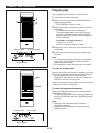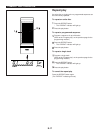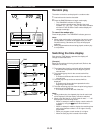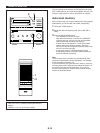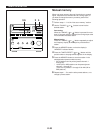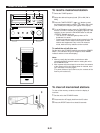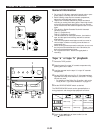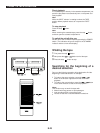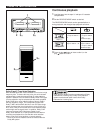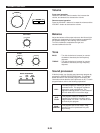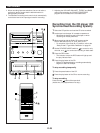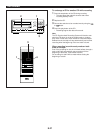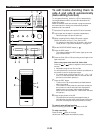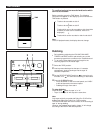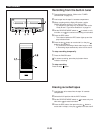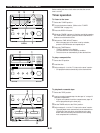
12
34
5
6
7
8
9
0
CLEAR
CALL
+
TIME
PROG
REPEAT
CD
BAND
TUNER
HALL
JAZZ CLUB
ROCK CNCT
OFF
POWER
AUX
DAT
VOLUME
TAPE
-
b
a
10
+
E-24
CASSETTE TAPE OPERATION
Continuous playback
1 Load the tapes into the tape “a” and tape “b” cassette
compartments.
2 Set the REVERSE MODE switch as desired.
The REVERSE MODE switch can be operated before or
during playback, and changes tape playback as follows:
3 Press the play button to listen to side A, or the
play button for side B.
Tape “a” Side A → B
→ Tape “b” Side A →
B
Tape “a” Side B →
Tape “b” Side A → B
Tape “a” Side A → B
→ Tape “b” Side A
→ B
Continuous play
Tape “a” Side B →
Tape “b” Side A → B
→ Tape “a” Side A
Continuous play
2
1
3(a) 3(b)
3(b)
3(a)
Dolby B and C Type Noise Reduction
With cassette tapes, the most noticeable form of noise is high
frequency hiss. To reduce this hiss noise, this unit has been
equipped with a newly developed Dolby C noise reduction
system in addition to its conventional Dolby B NR. Either type
of noise reduction may be selected with the switch provided.
Dolby B NR has a noise reduction effect of about 10 dB in
the high frequency range. The corresponding figure with
Dolby C NR is about 20 dB, but this is over the entire range
where the human ear is most sensitive to noise (2 kHz to 8
kHz). Also, Dolby C NR has the same noise reduction effect
at both high and low signal levels. In addition, Dolby C NR
improves the tape’s MOL (Maximum Output Level).
Dolby noise reduction is a 2 part process that acts both on
recording and playback; be sure that the noise reduction
button is set to the same position on record and play.
* Noise in the source material cannot be reduced with the
Dolby NR system.
Dolby and the double D mark are trademarks of Dolby
Laboratories Licensing Corp. Dolby noise reduction
system manufactured under license from Dolby
Laboratories Licensing Corp.
<Tape “a”>
<Tape “a”>



